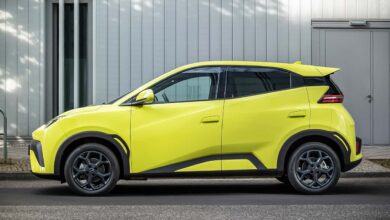Car Companies Once Had Global Ambitions. That Era Is Ending

Twenty years ago, Ford CEO Alan Mulally revitalized the company in part through his “One Ford” strategy. It saw the Blue Oval doubling down on its global ambitions while reducing the number of disparate vehicles for different markets. It seemed like the natural course for what was then a hyper-globalized world, rooted in the hope that consumers everywhere wanted similar things. But that’s not the world we live in anymore, and Ford’s current CEO knows it.
“I would say we’re encouraged by the level of engagement with Ford, with all lawmakers and the administration,” CEO Jim Farley said during Ford’s first-quarter earnings call. “They want a company like Ford that bet on America to win in this next era of the automotive industry that increasingly looks like a regional business.” (Emphasis mine.)
He continued: “I think we feel that as long as we do our jobs to engage key decision makers and all the policy areas around the world, that Ford will, you know, emerge as one of the companies that is in really great shape relative to the competition.”

“Regional” also used to be a broader term. The Ford Mustang Mach-E is built in Mexico, which used to be seen as part of the broad “North American” region. Now, though, the administration wants cars to be built within U.S. borders, giving automakers far fewer options.
Photo by: Ford
Gone are the days where a class of ultra-competitive global giants fight for the entire Risk board. Welcome to the new world, where protectionism is back, and where widely disparate consumer preferences are reshaping the game.
Why is The Auto Market Getting Less Global?
The first thing that likely comes to your mind is tariffs. Certainly, when he gestured toward the administration in his comments, that’s what was on Farley’s mind. What used to be a broadly low-tariff world for major markets like the U.S. and EU is now quickly becoming far less open, giving a strong home-court advantage to auto companies. If tariffs persist, only local companies or companies with primarily local footprints will be able to dominate.
“With the recent tensions, geopolitical and trade tensions, it seems that we are going backwards, and it seems that each big market is trying to protect its interest at the expense of free trade,” JATO analyst Felipe Munoz told InsideEVs.

It’s not all tariffs and regulations: Some products are built for specific markets, and wouldn’t do well elsewhere. Try getting a European to buy a Cadillac Escalade IQ.
Photo by: Cadillac
But that’s only a continuation of what was already happening, Munoz says. Because it isn’t just tariffs driving this retreat from globalized products. It’s consumers.
Consumers in different markets have wildly different expectations for vehicles. Chinese buyers demand advanced, software-defined EVs with flagship battery tech. U.S. consumers prefer big, gas-burning trucks and SUVs. European buyers are more open to EVs, but typically buy smaller vehicles. Japanese consumers have seemingly no interest in EVs, but they do want micro-cars.
Differing Approaches To EVs
Buyers’ varying preferences for size and features have always been an issue. But now, with electrification driving another wedge, it’s getting harder to align products that can satisfy consumers in multiple markets. Consumers in the EU and China have no use for V-8 pickup trucks, while U.S. consumers have soundly rejected every small, cheap EV that’s reached our shores.
China also prefers big vehicles and likes plug-in hybrids, so in theory, those products could make sense for the U.S., or vice versa. But tensions between China and the U.S. are high. U.S. consumers have no access to Chinese vehicles, and Chinese consumers prefer local brands. Munoz doesn’t see that trend reversing anytime soon.

BYD offers cars that can charge from 5-60% in around 5 minutes, alongside extremely affordable EV options. It’s hard to imagine Western automakers winning in its home market.
Photo by: BYD
“The world is becoming more paranoid, paranoid in the way that they don’t want to share their knowledge anymore,” he said. “The West realized that this policy that China had—in the way that if you wanted to sell anything in China, you have to share your know-how with them and have a joint venture with them—they realized that it was it turned against them, because they shared what they knew. And now Chinese companies have, in many cases, outperformed their former teacher. In this case, the Western car makers.”
The U.S. has responded to this not just with tariffs, but also bans on Chinese software in cars. That effectively locks them out of our market. The European Union also put steep tariffs on Chinese EVs, and is threatening to hit U.S. autos with more tariffs in response to Trump’s blanket 25% import duty for cars. This is why Farley says he needs to “engage key decision makers;” running a car company these days is also about making sure you don’t get caught in the geo-political crossfire.
This threat comes through in a variety of ways. While Ford ditching its cars and launching relatively middling EVs in Europe has hurt the brand’s fortunes there, so too has Chinese competition, Munoz says. The company is “very exposed” to Chinese competition in the EU. Think about it: If you’re going to pay an import tariff to buy a foreign product, you’re probably going to go with a brand that has the smaller, electrified vehicles you want.

The EU-market Ford Explorer is basically just a Volkswagen EV underneath.
The Rest Of The World
“The world” is not composed of the EU, the U.S. and China, even if those are the biggest auto markets. Much of the battle for global buyers is being waged in the Middle East, Latin America and Southeast Asia. In these markets, Toyota tends to dominate. Munoz says it’s clearly the most global automaker.
But even these countries will find themselves fragmented. Some countries do not have the money or political appetite to transition to EVs, while others are racing ahead, fueled in some cases by cheap Chinese EV options. These disparities are likely to grow, not shrink. Countries with the wealth and consumer appetite to go electric will blaze that path. Countries with worse infrastructure and consumers who either can’t afford or don’t want EVs will hold onto internal combustion cars for longer.
What Does This Mean?
This all tracks with what I heard from a Nissan executive during my time at the company’s headquarters. The world is getting split up in new ways, and old approaches to success may not carry over. The world was already split by which consumers wanted and could afford big cars. Now it’ll also be split on who wants and can afford EVs.
That leaves precious few markets that are aligned enough for global products to make sense. Sure, you may be able to sell big gas guzzlers in the Middle East and the U.S., but those products are already doomed in Europe. You may be able to sell the same sort of smaller electric vehicles in Europe and China, but consumer software preferences and trade/sales barriers mean that we’re unlikely to see VW top the charts in China again.
The world, it seems, is getting divvied up in new and confusing ways. The U.S. market will belong to the companies that can navigate its regulatory and consumer environment and ensure local production, while China will be dominated by Chinese firms. This may be good news if you’re a home-team firm in a country with a big automaker. But for consumers, one axiom holds true. Less competition always leads to fewer good options for buyers.
Contact the author: Mack.Hogan@insideevs.com.
Source link


